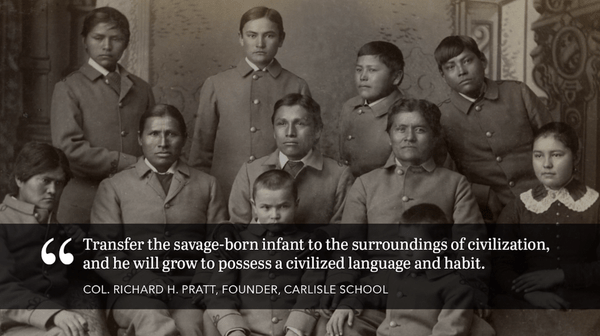Going to school for the first time is always rough. It’s every child’s annoyance and even disdain when it comes to school. Carlisle seemed like any ordinary school. It had classrooms, teachers, libraries, things that any school would have. Only this school had a unique purpose. This school was not for everyone; in fact, it was only for one group of people: Native American children. The purpose of this school was to strip these Native American children of every native tradition and custom they ever had. Their traditional clothing made of soft leather and Mulberry and redwood bark were replaced with uniforms.1 These childrens’ names were officially changed to Christian names, and they were forbidden to speak their native languages while on school premises; all teaching instruction was in English.2 Additionally, both boys and girls had to have their hair cut to an appropriate length, which was based on Anglo-Saxon cultural norms. After the students had their hair cut and their Native garb removed, they would have to choose a Christian denomination.3 The one connection the students had to their culture was one ritual dance that was performed by the students for the comic entertainment for visitors. Any other traditional dances or rituals were prohibited.4 How did this school come about?

After multiple failures of the United States government to suppress Native Americans though the use of brutal military campaigns, Thaddeus Pound, a third-term US congressman, promoted the idea of assimilation. In 1881, he proposed that it would be cheaper and easier to assimilate Native Americans rather than to continue fighting them. Stressing the civilizing of Native peoples, Pound pressured Congress that this had to be done for humanitarian purposes. The real purpose, however, was to sever the children culturally and psychologically from their culture, thus saving the Indian but at the same time destroying them by destroying their culture.5 Through this debate came the notion of educating Native children into white culture and erasing their culture through the use of forced assimilation.
The Carlisle Indian Industrial School opened in 1879 in Carlisle, Pennsylvania, by Lieutenant Richard Henry Pratt with 136 Native American Children.6 However, at the turn of the decade, the federal government acknowledged assimilation practices as Indian Policy. Carlisle then became approved as a role model for other off-reservation schools, which led to the creation of twenty-three other similar schools.7 By 1902, the number of such schools had jumped to ninety-two schools managed by the Federal government nation-wide.8 The Carlisle Indian Industrial School focused mostly on teaching low level skills to children, training them for jobs as servants and manual laborers. Education at Carlisle only lasted three years with a focus on basic English, math, writing, and labor skills.

Over time, classes grew to include students who graduated from the eighth grade and higher levels of education. After graduating, most students returned to the reservation to do small jobs such as shoe making, printing, or tailoring. Unfortunately, most of these trades proved useless on the reservations.9 Carlisle, along with other off-reservation schools across the US, held large celebrations and parades dedicated to showing the transition of students from Natives to Anglo-Saxon Americans through the use of parades, floats, and the occasional play. Most of these carried offensive and racist messages, such as “Anglo-Saxons rule the world, we submit” and “wise statesmanship demands a homogeneous population,” which were used to promote and prove the power of assimilation over Native-American populations. This led to the belief that Native culture was just a dream and not something that will grow into the Anglo-Saxon culture.10

Carlisle also sponsored extracurricular activities, which included a music program, a student-run newspaper, and a library. Most of these programs were unintended by the federal government and were created mostly by donors, teachers, and the students themselves. For instance, the library was created through the efforts of O.H. Bakeless and Pratt, who wanted Native children to have access to encyclopedias, medieval stories, and Greek and Roman history. Along with that, they added classics such as Little Women, Black Beauty and religious texts. Teachers and sponsors also played a key roles in growing the school and encouraging pupils to grow outside of the low level jobs the federal government intended for them, by providing additional funds and resources.11
The Carlisle experience had lasting repercussions for these children. Some children were able to leave reservations and find substantial employment, but unfortunately, the overall effects leaned towards the negative rather than the positive spectrum. Children experienced cultural isolation, which led to homesickness, and in extreme cases, to alienation and depression when they returned to reservations. Families that were reluctant to send their children to federal schools faced threats from the government that included removing federal funding and welfare from the family. Hence, even if the child or the family didn’t want to attend Carlisle or other schools, they had no choice. 12 Gertrude Bonnin, also known as Zitkala-sa, was a former student from Carlisle and went on to become a teacher at the school. She, like many students, had been scouted out by missionaries prior to attending Carlisle Indian Industrial School. In her case, she was recruited by the Manual Labor Institute, a Quaker mission school in Indiana. She was recruited at the age of eight, and she recalled the traumatic experiences she and others faced when going through the assimilation process. In her essay, School Days, she recalls how she hid from teachers when they told her they were going to cut her long, traditional braids. They ended up dragging her out from under a bed, tying her to a chair, and then cutting her braids with a pair of scissors. She describes this moment as the moment she lost her spirit. After Carlisle, she found herself alienated from her traditional mother and struggled to reconnect with her family for the rest of her life. She became a teacher at Carlisle for two years before going on to found the National Council of American Indians in 1926, where she served until her death in 1938. She was a prominent Native-American rights activist.13

After years of forced assimilation, the connection between the Native Americans and the Federal government became extremely fragile. With that, Native Americans decided to create laws that only effected Native Americans. The federal government agreed to this in order to reconcile with the Native peoples and let these special laws pass. The major laws were aimed towards Native-American children with the most famous one being the creation of ICWA or the Indian Child Welfare Act.14
Out of the 10,000 that went into Carlisle, 186 children from nearly fifty different tribes died, most dying of illnesses such as tuberculosis, influenza, and trachoma, an infectious eye disease. Tuberculosis, however, was the deadliest of the three. Families of the deceased children could not claim the bodies of the children, so the children’s bodies were never returned to the tribe. The children instead were given Christian burials and were buried in the Carlisle cemetery. It wasn’t until the year 2000 that the children were given proper Native burial rites, but unfortunately, the correct identification of each body had been lost due to time, loss of accurate documentation, and several relocation projects on the Carlisle Cemetery. The school is now an active military base with the cemetery located right behind the army barracks known as the Carlisle Barracks.15
- Fashion, Costume, and Culture: Clothing, Headwear, Body Decoration, and Foot wear through the Ages, 2013, s.v. “Clothing of Native American Cultures,” by Sara Pendergast, Tom Pendergast, Drew D. Johnson, and Julie L. Carnagie. ↵
- Encyclopedia of Genocide and Crimes against Humanity, 2005, s.v. “Native Americans,” by Stacie E. Martin. ↵
- Mary A. Stout, Native American Boarding Schools (Santa Barbara: ABC-CLIO LLC, 2012), 32, 34, 36. ↵
- American Eras: Primary Sources, 2013, s.v. “The Indian School at Carlisle Barracks,” by Rebecca Parks. ↵
- Scott Laderman, “‘It is cheaper and better to teach a young Indian Than to Fight an Old One’: Thaddeus Pound and the Logic of Assimilation,” American Indian Culture And Research Journal 26, no.3 (2002): 9-10. ↵
- Encyclopedia of Race and Racism, 2013, s.v. “American Indian Boarding Schools,” by Jon Reyhner. ↵
- Mary A. Stout, Native American Boarding Schools (Santa Barbara: ABC-CLIO LLC, 2012), 42. ↵
- American Eras: Primary Sources, 2013, s.v. “The Indian School at Carlisle Barracks,” by Rebecca Parks. ↵
- Mary A. Stout, Native American Boarding Schools (Santa Barbara: ABC-CLIO LLC, 2012), 38, 42. ↵
- John R. Gram, “Acting out Assimilation: playing Indian and becoming American in the federal Indian boarding schools,” The American Indian Quarterly 40, no. 3 (2016): 1-5. ↵
- Bernadette A. Lear, “Libraries and Reading Culture at the Carlisle Indian Industrial School,” Book History 18, (2015): 168, 173. ↵
- Encyclopedia of Race and Racism, 2013, s.v. “American Indian Boarding Schools,” by Jon Reyhner. ↵
- Mary A. Stout, Native American Boarding Schools (Santa Barbara: ABC-CLIO LLC, 2012), 36-37. ↵
- Timothy Sandefur, “Suffer the Little Children: US laws treats Native American Children very different from Other Children,” Regulation 40, no. 4 (2017): 1-3, 5. ↵
- Jacqueline Fear-Segal, “Institutional Death and Ceremonial Healing far from Home: The Carlisle Indian School Cemetery” Museum Anthropology 33, no. 2 (September 2010): 157-159, 164-165. ↵



53 comments
Robert Rodriguez
I always knew that Native Americans were oppressed for as long as “America” has existed but I never knew that made schools in order to kill off their culture to convert them to white culture. The extent that these people went to make their culture superior is crazy.. its also crazy to think that these Christians treated them so poorly and didn’t give the families the deceased bodies of their children… The article was very informative. Great job!
Carlos Vazquez
The history of Native Americans in the United States is incredibly sad. The way the government continued to push the natives out of their land and forced them to suppress their culture led to the creation of schools like Carlisle. This article was really well written and informative, I enjoyed reading it. I had never heard of this story and its incredibly sad to hear that Native Americans had to endure this treatment
Saira Castellanos
I do not understand what went on through peoples minds back then. I really dont get why anglos wanted everyone to be like them. I get that they wanted to ‘save’ people, but their had to be a better reason than that. This is a huge black spot in American history, as well as the Trail of Tears. We owe so much to the native americans for destroying their culture. I love Ameirca, but i would not want to be part of the America that we were, because i would be starving and broke somewhere in a poor town because i am not white. I feel so bad for these children that had to go through these schools. Good article.
Iris Henderson
The author chose a great subject topic, the story of the Carlisle Indian Industrial School is not a commonly written topic. It was interesting and sad to learn how the Native American children were essentially stripped of their culture and subjected to this Anglo-Saxon assimilation process. As a multicultural nation now, it is easy to see how unjust and wrong it was to do this. We still have growing to do in the sense of accepting cultures but this article reminds us why we cannot repeat our mistakes.
Hanadi Sonouper
This was a very well explained and descriptive article, I admire the author for selecting this particular topic because it was an excellent selection. I enjoyed reading this article because of the historical aspect, previously I have never heard of the Carlisle School but after hearing about it, it was an unfortunate reverse of culture. The Native American’s were inhabitants of the Americas before anyone, therefore their presence should have been treated with as much respect as anyone else. It was terrible to read that these children were stripped of what their entire lives traditions to conform to society around them, they were treated with so much disrespect. The author did an excellent job at presenting the information and illustrating this particular aspect of the Native Americans that nobody has heard of.
Hannah Wilson
The fact that the government forced children to change their way of life simply because it was different is only one of the many unfair acts that America inflicted onto native Americans. Our history with them is heartbreaking and often times filled with negative events. However, some teachers and staff were trying to help the children to be able to adjust better and have better jobs. Maybe they did not realize that they were taking away their families and culture, and that by ding so could harm the children more than benefit them.
Michael Thomas
I found this article interesting because of how it details the lives of Native Americans that were forced to assimilate into American society. I have heard about the assimilation of Native Americans in high school, but not about the Carlisle Indian Industrial School. Around the time this happened, Native Americans were forced off their lands and were told to assimilate with society. Overall, this article was good.
Belia Camarena
This article was very well written, and I think the author did a great job of explaining the Carlisle Indian school. Prior to reading this, I had never heard of the Carlisle school. Even though I remember learning about forced Native American assimilation, I never knew that the United States government took such extreme measures to enforce this policy. What these children had to endure is awful; they were completely stripped of their identity.
Regina De La Parra
I remember learning about this in my History class in high school but never in such detailed way. I can’t even imagine what I would do myself in that situation as my roots and culture is forcibly stripped away. I do remember learning in high school how many would revel and do little acts to show their identity, like wearing native clothing in secret under their uniforms. I really liked to see this article because I do not know a lot of the Native Americans and to be able to learn this information is a great opportunity for everyone. Great job Natalia!
Rafael Lopez-Rodriguez
This is a very sad story but yet so informative. I have never heard of the Carlisle School systems. It is extremely sad that these kids were being forced to be Americanized and honestly this is not the first time the US has tried to do this and failed. The fact that the US government attempted to destroy a culture in a way is heart breaking. Going to school for every kid should be an experience that will help them for the future. Very good article!